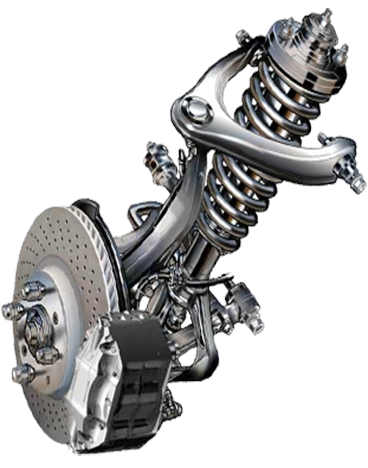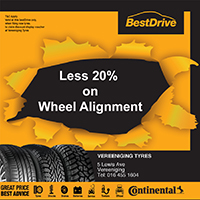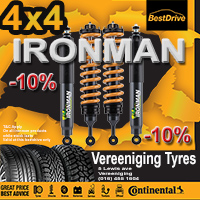
Suspension and Steering
Complaints of poor steering, ride and handling can be difficult to diagnose because of the complex relationships among a vehicle's steering system, suspension, alignment and wheels.
Problems with one system may be caused by another. The best way to find and correct a particular problem, as well as to find other problems or potential problems, is to "do it right" by checking the entire steering and suspension system.
Only after completing this thorough inspection can you provide the customer with an accurate assessment of the condition of his vehicle.
GREAT DEALS- Vereeniging Tyres Services
- Symptoms
- Maintain
What Does a Suspension Check Include?
During a full Suspension, Vereeniging Tyres will:
- Steering
- Check the power steering fluid level and type.
Check the power steering pump shaft seal for signs of leakage.
Check for leakage at all steering components, including inside the bellows of the rack & pinion unit.
Check the tension of the power steering pump belt.
Raise the vehicle and check for excessive play, travel, binding, wear or damage to all steering components. Inspection on steering wheel freeplay for excessive travel.
Ball joint will be checked, to see if it's recessed into the housing, indicating the need for replacement. - Suspension
- Test the shocks by bouncing the vehicle at each corner. If it bounces more than a couple of times, take a closer look at the shocks or struts. Although many techs don't use this test any longer, it can still be used to pinpoint problems on many vehicles.
Check the ride height of the vehicle.Check for damage to the sway bar.
Check suspension components manually to check for looseness. Most worn or damaged components can be found using this method.
Examine the suspension bushings for cracking, deterioration and wear.
With the vehicle raised, we will inspect for binding at the ball joints or struts while turning the steering wheel lock-to-lock.
Check ball joints for proper lubrication-both quantity and quality.
Check ball joint play.
Inspect the shocks for damage and fluid leaks. Check the seals for leakage and the piston rods for signs of damage and wear.
Examine the bump stops for damage caused by "bottoming out." Bump stops that show repeated contact indicate the need for new springs, as well as struts or shocks.- Inspect the tyres for correct inflation pressure and make sure they're all the same size.
Inspect the wheel bearings for damage.
Perform a courtesy inspection, where the automotive technician will:
- Top off fluids (including window washer fluid and engine coolant)
- Lubricate chassis as necessary
- Inspect belts, hoses, skid plates and undercarriage
- Check car battery
Signs and Symptoms Your Vehicle Suspension and Steering
Needs Attention:
- Suspension problems usually show up in the form of customer ride control complaints. Heavy "body lean" in turns, "nosediving" while braking, a "floating" or "bouncing" sensation or heavy "shudder" or vibration from bumps and potholes indicate something is amiss in the suspension system.
- Steering problems usually consist of handling difficulties, noises, hard steering or fluid leakage.
- Let a qualified technician check your suspension every 6 to 12 months. When you start to feel play on the steering wheel, any noises when turning or driving over bumps. If anything feels different on the steering even if this is not causing a immediate problem, you need to have it checked out asap.
BE SAFE.
Also, you might be interested in:
T&C Apply on all Special & Limited time Offers
Select offer for voucher with T&C's

4x4 Services
4x4 Armour, LED Lights, 4x4 Suspension...

Tyres
Continental, Pirelli, BF Goodrich...

Vereeniging Tyres
About Us...





